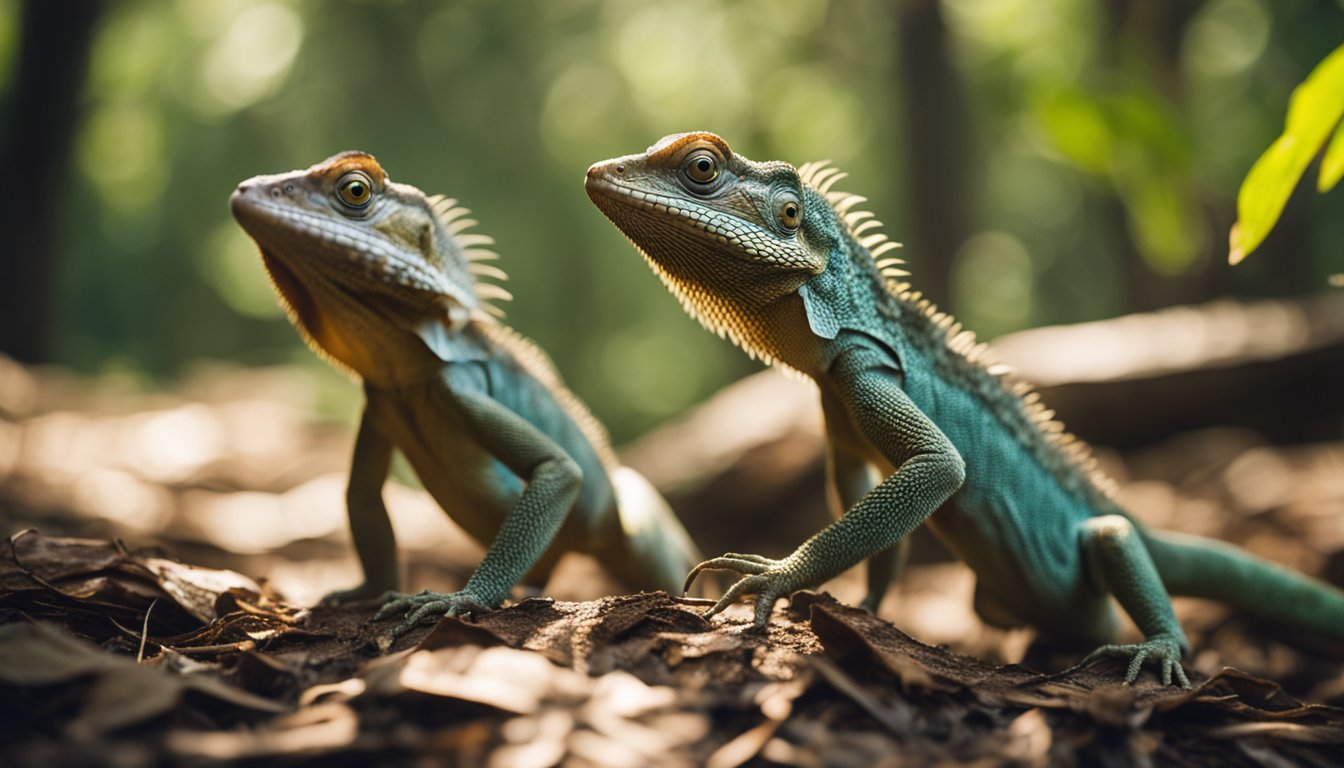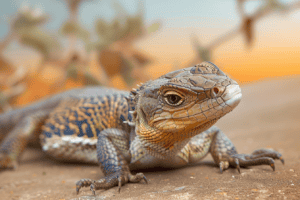Imagine wandering through the dry woodlands and forests of Australia when you spot a creature with a remarkable ruff of skin around its neck.
This isn’t a creature from a fantasy story; it’s a frilled lizard!
These fascinating reptiles have a unique way of intimidating predators and showing off to potential mates – by unfurling their large, colorful frills around their necks.
While they may seem like quiet creatures, when threatened, they stand up on their hind legs, open their bright red or yellow mouths, and splay their striking frills to look much larger and scarier than they actually are.

Frilled lizards are not only known for their dramatic displays but also for their peculiar way of moving. Have you ever seen a lizard run on two legs?
If not, watching a frilled lizard in action would certainly be a treat.
When fleeing from danger, they sprint on their hind legs to escape, a sight that’s both amusing and astonishing.
It’s like seeing a little dinosaur dash away!
These lizards are part of the dragon family, and while they can’t breathe fire, their frill flair is enough to make anyone believe in mythical creatures.
Kids might be surprised to learn that the diet of a frilled lizard consists mostly of ants and other small insects.
They are skilled hunters, using their keen sense of sight to catch their tiny prey.
These scaly friends spend most of their time up in the trees, perfectly camouflaged among the leaves and branches.
This not only helps them ambush their next meal but also keeps them safe from predators lurking below.
With their quirky behaviors and fascinating appearance, frilled lizards spark curiosity and a sense of wonder about the diverse world of reptiles.
What Are Frilled Lizards?
Frilled lizards are unique reptiles known for their dramatic displays and prehistoric appearance.
They captivate onlookers with their startling behavior and distinctive physical traits. Let’s get up close and personal with these scaly creatures.
Appearance and Anatomy
With long, slender bodies covered in scales, frilled lizards have a look that makes them stand out in the reptile world.
They can grow up to 90 centimeters in length, and their color can vary from brown to nearly black, often with patches of orange or red.
These colors help them blend into their natural surroundings, a clever trick to hide from predators.
The rough texture of their skin gives them an even more formidable appearance.
Behind all that tough exterior, frilled lizards are actually quite nimble and are excellent climbers.
The Famous Frill
Imagine a lizard suddenly spreading a large, colorful frill around its neck—that’s the frilled lizard for you!
This unique feature is where the lizard gets its name.
The frill is usually folded neatly against the body but opens up like an umbrella when the lizard feels threatened or when it’s trying to intimidate other animals.
It’s not just a fancy accessory; it’s a warning signal!
The frill’s bright colors and bold patterns are hard to miss, and they make the lizard seem much larger than it is to any potential threat.
Habitat and Distribution
Frilled lizards live in warm climates, usually in areas with lots of trees like woodlands, forests, and savannas.
They’re most commonly found in northern Australia and southern New Guinea.
Their choice of habitat allows them to bask in the sun high up in the tree branches and leap down to the ground when they need to hunt or dash away from danger.
The tree-dwelling nature of frilled lizards means they’re well-adapted to life both in the treetops and on the land, making them versatile and fascinating survivors in their natural habitats.
Behaviors and Lifestyle

The frilled lizard is a creature of many wonders, from its flamboyant defense displays to its sun-soaked daily routines.
In exploring their behaviors and lifestyle, we’ll learn just how this unique reptile thrives in its environment.
Daily Activities
Frilled lizards are remarkable diurnal reptiles, meaning they’re active during the day.
When the sun climbs up the sky, they venture out to bask in the warm rays, something they can’t seem to get enough of.
Have you ever seen lizards stretched out on rocks, soaking up the sun?
That’s because the heat gives them the energy they need to go about their day.
In the cooler hours of dusk and dawn, they can often be found hunting for their meals.
Defense Mechanisms
When predators loom close, the frilled lizard exhibits one of nature’s most theatrical defense maneuvers.
They burst open their colorful frill, creating an imposing umbrella around their necks to seem larger and less appetizing.
Can you imagine a small lizard suddenly looking so big?
Alongside this impressive frill-display, these lizards will often open their mouths wide and hiss to ward off the threat.
If this spectacle still doesn’t do the trick, their next move is to run—surprisingly, on two legs—to find the nearest tree to climb and escape danger.
Diet and Hunting
Let’s sneak a peek into the frilled lizard’s diet, which mainly comprises insects like ants and termites.
They are skilled hunters; they wait patiently and motionless, blending into their surroundings until a tasty bug ventures too close.
Then, with lightning-fast reflexes, they strike, capturing their prey with their sharp teeth.
Occasionally, they may also snack on smaller lizards and plant material, showing us they aren’t picky eaters at all.
Reproduction and Life Cycle

The marvelous frilled lizard has a fascinating beginning to life that starts in the warmth of a cozy nest.
These scaly friends are egg-layers, with momma lizards typically depositing 8 to 23 soft-shelled eggs in a snug burrow.
They use their hind legs to dig a safe place for the eggs, or they might cleverly use an abandoned termite mound.
Did you know the warmth, or temperature, of the nest can decide whether the babies will be boys or girls?
Incubation takes about two to three months, and mother lizards don’t stick around; once the eggs are laid, the babies are on their own.
When the youthful lizards hatch, they already look like tiny versions of their parents, frills and all!
As for life after hatching, these charismatic critters are rather secretive.
They grow up on a diet of ants, spiders, and smaller lizards, learning to hunt from an early age.
Frilled lizards can live up to 10 years in the wild – a whole decade of dazzling displays with their flamboyant frills.
Imagine seeing a frilled lizard expand its frill; it’s like a magician showing off a colorful new trick!
From birth to adulthood, frilled lizards are a brilliant example of nature’s ingenuity.
She makes sure these creatures are equipped with everything they need for survival, even if the little ones must brave the world without their moms.
Isn’t it incredible how nature works?
Conservation Status and Human Impact

The frilled lizard is a creature straight out of a fairy tale, with its dramatic neck frill and swift, bipedal escape runs.
She’s not just playing dress-up, though; her frill is her secret weapon for survival!
These unique reptiles, native to northern Australia and southern New Guinea, are often spotted balancing on their hind legs, peeking through the grass like tiny, scaly sentinels.
When it comes to their place on our planet, frilled lizards hold the status of “Least Concern” on the IUCN Red List. That’s good news!
It means they’re currently not at immediate risk of extinction.
But wait, their tale isn’t all sunshine and insects—they face ongoing threats from their human neighbors.
Their habitats are being altered by land clearing for agricultural and urban development.
Just imagine your home turning upside down, not so comfy anymore, right? That’s how these lizards feel about these changes.
Moreover, feral cats and dogs that humans have brought into their territories love to snack on these little dinosaurs, causing their numbers to sneak downwards like a lizard slinking into the underbrush.
Kids, just like you are the guardians of tomorrow, and these frilled wonders need protectors.
Every piece of litter picked up, every plant grown, and every person told about the importance of these creatures helps safeguard their future.
Isn’t it spectacular to think that every one of us can be a hero for wildlife?
By understanding the impact humans have, one can learn to change the course of the future for species like the frilled lizard.
So, the next time you see a lizard, maybe say a little thank you for all the insect-control they do, helping to keep the ecosystem balanced on their tiny, yet mighty, shoulders.
Frequently Asked Questions

In this exciting section, kids will uncover the mysteries of the frilled lizard, discovering their dazzling traits, favorite snacks, survival strategies, and much more.
Prepare to be amazed by these scaly wonders!
What are the unique features of frilled lizards that children find fascinating?
Spotting a frilled lizard is like glimpsing a tiny dinosaur in the wild!
What catches one’s eye first is the large, colorful frill around their neck.
They display this magnificent frill when scared, looking much larger to a would-be attacker.
Plus, these lizards have a quirky way of moving – when they want to go fast, they rise up and sprint on their hind legs!
Can you guess the various foods that make up the frilled lizard’s diet?
Frilled lizards are not fussy eaters.
Their diet is mostly made up of juicy bugs, such as ants and spiders, but they also chomp on other smaller lizards and even some succulent plants.
They use their keen sense of vision to spot a tasty meal, and then it’s chow time!
Ever wondered about the lifespan of a frilled lizard and what factors contribute to it?
Frilled lizards enjoy a relatively long life for such small creatures, living up to 10 years in the wild.
Their lifespan is influenced by various factors including their habitat, availability of food, and of course, their success in evading predators.
How do frilled lizards defend themselves against predators?
Aside from unfurling their spectacular frill to scare off enemies, frilled lizards have another awesome trick – they can be quite the sprinters!
On those rare occasions when their frill isn’t enough, they’ll bolt, using their powerful hind legs to escape danger in a hurry.
What’s the secret behind the frilled lizard’s ability to shed its skin?
Just like snakes, frilled lizards shed their skin as they grow – a process known as ecdysis.
This isn’t just any wardrobe change; shedding helps them remove parasites and keeps their scales fresh and clean.
It’s a vital part to staying healthy for these reptiles.
Where in the world can you find frilled lizards in their natural habitat?
These charismatic lizards are typically found lounging in the warm regions of northern Australia and southern New Guinea.
They adore the heat and often bask on rocks or branches, blending in with their bushy backdrop, making them camouflaging artists of the reptile world.









